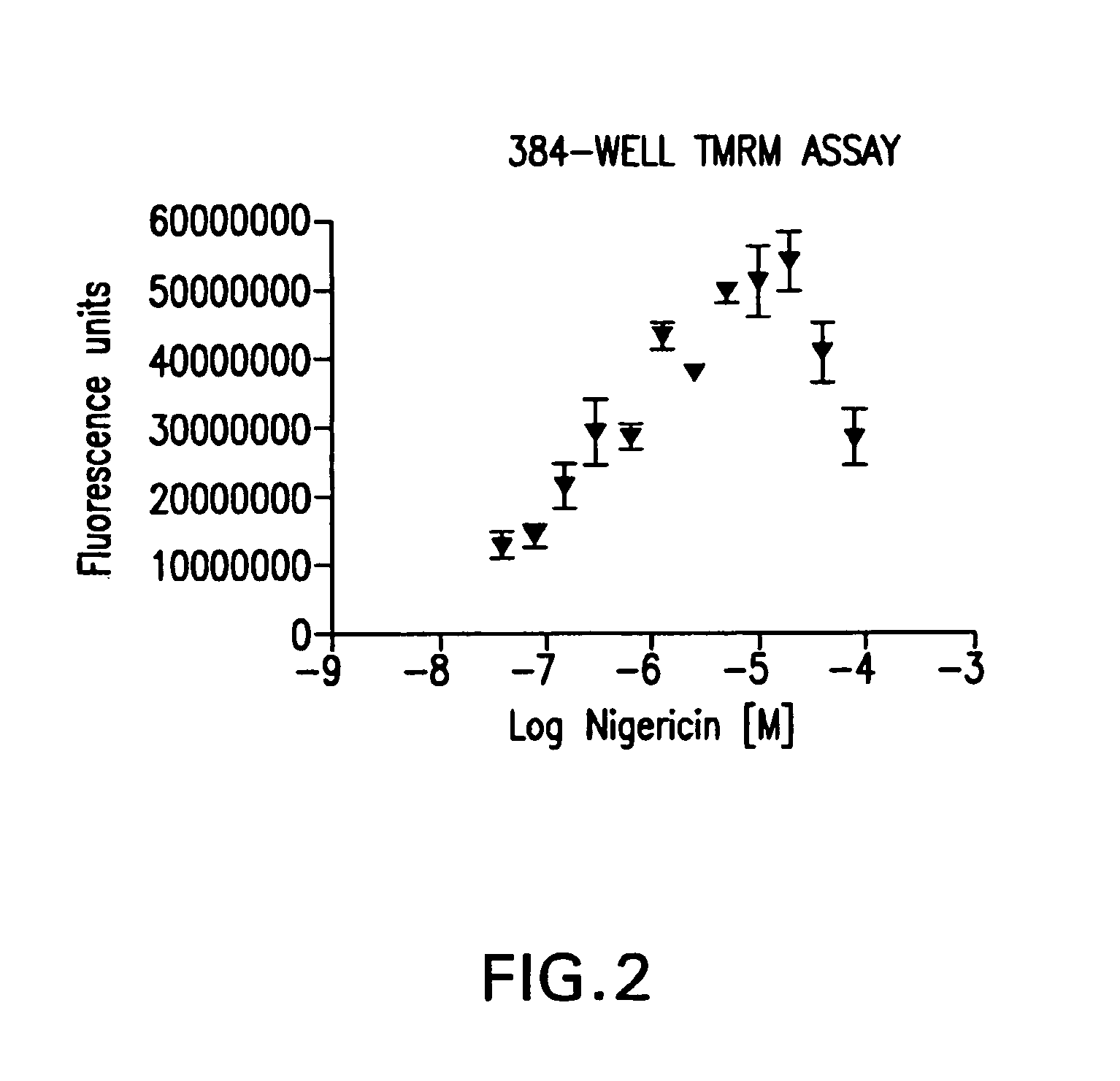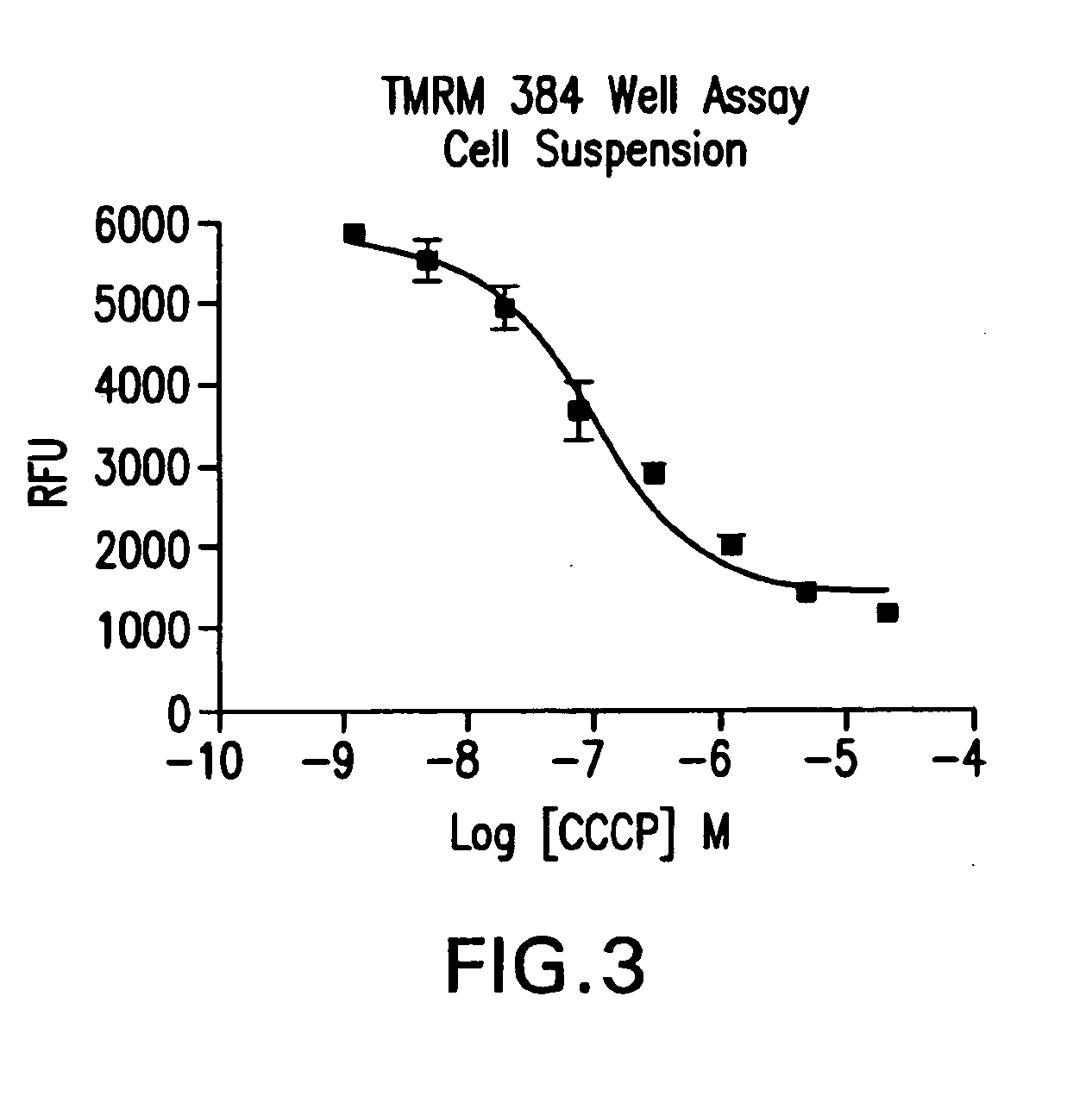Method for measuring mitochondrial membrane potential in vertebrate cells
a technology of mitochondrial membrane potential and homogeneous assays, which is applied in the direction of measurement devices, biochemistry apparatus and processes, instruments, etc., can solve the problems of affecting the function of mitochondrial function, so as to achieve the effect of improving mitochondrial function
- Summary
- Abstract
- Description
- Claims
- Application Information
AI Technical Summary
Benefits of technology
Problems solved by technology
Method used
Image
Examples
example 1
[0081]In order to determine if an inner filter would permit omission of wash steps used in a TMRM-based mitochondrial membrane potential assay, the dye Brilliant Black BN was used as a potential inner filter. Mitochondrial activity was assessed using the uncoupling agents 2,4-DNP and CCCP.
[0082]24 hours before assay, CHO—K1 cells were seeded in a 384 well plate at 75,000 cells per well in 50 μl growth medium (Iscove's Modified Dulbecco's Medium Invitrogen, 12440-046, 10% Fetal Bovine Serum (Invitrogen, 26140-095), 1× HT Supplement (Invitrogen, 11067-030) 1× Penicillin-Streptomycin solution (Hyclone, SV30010) 2 mM Glutamine (Hyclone, SH30034.01). Cells were then incubated overnight at 37° C., 5% carbon dioxide. When commencing the assay, 50 μl of assay buffer (50 mM Hepes, pH 7.4 150 mM KCL, 1600 mM NaCl, 25 mM D-(+)-glucose) was added to cells. 1 μl of the various amounts of the mitochondrial chemical uncouplers 2,4-DNP or FCCP was added and the cells are then incubated for 30 minut...
example 2
[0084]In order to determine a range of measurement using the homogenous membrane potential assay, an experiment was performed using the cation ionophore, nigericin, known to hyperpolarize mitochondria due to its H+—K+ exchange activity between the mitochondrial matrix and inner mitochondrial membrane.
[0085]24 hours before assay, CHO—K1 cells were seeded in a 384 well plate at 75,000 cells per well in 50 μl growth medium (Iscove's Modified Dulbecco's Medium, lnvitrogen, 12440-046, 10% Fetal Bovine Serum (Invitrogen, 26140-095), 1× HT Supplement (Invitrogen, 11067-030) 1× Penicillin-Streptomycin solution (Hyclone, SV30010) 2 mM Glutamine (Hyclone, SH30034.01). Cells were then incubated overnight at 37° C., 5% carbon dioxide. When commencing the assay, 50 μl of assay buffer (50 mM Hepes, pH 7.4 150 mM KCL, 1600 mM NaCl, 25 mM D-(+)-glucose) was added to cells. 1 μl of the various amounts of the cation ionophore, H+—K+ antiporter, nigericin, was added and the cells are then incubated fo...
example 3
[0087]In order to determine if the homogenous assay can measure membrane potential in dissociated adherent cells or cells which do not grow adhering to substrate, the homogeneous assay was performed using dissociated cells. At time of assay, CHO—K1 cells were dissociated from growth substrate by washing cells with phosphate buffered saline and the incubating the cells in enzyme-free cell dissociation buffer (Speciality Media) at 30 μl solution per cm2 surface area. Cells were resuspended in Suspension Assay Buffer (25 mM HEPES, pH 7.4, 75 mM KCl, 80 mM NaCl, 25 mM D-glucose). 100,000 cells in 100 μl of suspension assay buffer were placed in wells of a 384-well plate. 1 μl of the various amounts of the mitochondrial uncoupling compound, CCCP, were added and the cells are then incubated for 30 minutes at 37° C., 5% carbon dioxide. 10 μl of 9 μM fluorescent dye TMRM (in 10% DMSO) was added and cells are incubated for 20 minutes at room temperature. 10 μl of 16 mM Brilliant Black BN pre...
PUM
 Login to View More
Login to View More Abstract
Description
Claims
Application Information
 Login to View More
Login to View More - R&D
- Intellectual Property
- Life Sciences
- Materials
- Tech Scout
- Unparalleled Data Quality
- Higher Quality Content
- 60% Fewer Hallucinations
Browse by: Latest US Patents, China's latest patents, Technical Efficacy Thesaurus, Application Domain, Technology Topic, Popular Technical Reports.
© 2025 PatSnap. All rights reserved.Legal|Privacy policy|Modern Slavery Act Transparency Statement|Sitemap|About US| Contact US: help@patsnap.com



